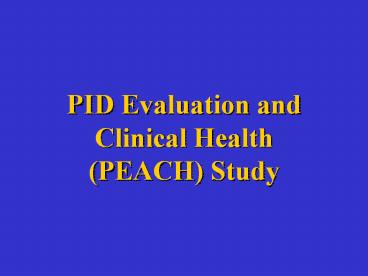PID Evaluation and Clinical Health (PEACH) Study - PowerPoint PPT Presentation
Title:
PID Evaluation and Clinical Health (PEACH) Study
Description:
PID Evaluation and Clinical Health (PEACH) Study PEACH Multi-center randomized clinical trial of 831 women followed 2-5 yrs through 10/00 Study treatment Inpatient ... – PowerPoint PPT presentation
Number of Views:60
Avg rating:3.0/5.0
Title: PID Evaluation and Clinical Health (PEACH) Study
1
PID Evaluation and Clinical Health (PEACH) Study
2
PEACH
- Multi-center randomized clinical trial of 831
women followed 2-5 yrs through 10/00
3
Study treatment
- Inpatient
- 2gr Cefoxitin IV
- every 6 hours
- 100grs Doxiciclyne IV
- Every 12 hours
- Outpatient
- 2gr Cefoxitin
- 1gr Probenecid
- 100 mg Doxiciclyne oral twice a day
1 shot
4
Eligibility of patients into the study
- Inclusion
- (Must meet all of the following criteria)
- 37 years of age or younger
- Willing to participate
- Presenting with a history of pelvic discomfort
for lt30 days (this does not need to be the chief
complain) - Experiencing pelvic organ tenderness (uterine or
adnexal tenderness) on bilateral examination - Leukorrhea and/or Mucopurulent Cervicitis and/or
untreated known GC or CT
5
Eligibility of patients into the study
- Exclusion
- (Must not meet any of the following criteria)
- Currently pregnant by urine testing.
- Tubo-ovarian abscess.
- Appendicitis, hemorrhagic ovarian cyst or other
condition requiring surgery by ultrasound or
laparoscopy. - Nausea or vomiting after a trial of metocopramide
- Antimicrobial therapy within the past 7 days
6
Eligibility of patients into the study
Exclusion 6. Delivery, abortion or gynecology
surgery with the past 30 days. 7. Prior
hysterectomy or bilateral salipingectomy. 8.
Allergy to penicillins, cephalosporins or
tetracyclines. 9. Homeless.
7
(No Transcript)
8
Outcomes
- Primary
- Involuntary infertility
9
Others Outcomes
- Short term
- Time to clinical improvement
- Microbiologic cure on repeat cervical culture and
endometrial biopsy - Patient satisfaction with medical care
- Treatment adherence
10
Others Outcomes
- Long term
- Tubal occlusion in women with involuntary
infertility - Repeat episodes of PID
- Ectopic pregnancy
- Functional decline due to pelvic pain
- Quality of life
- Frequency of health service use and indirect
PID-related cost, cost-utility analysis
11
PID Evaluation and Clinical Health (PEACH) Study
Adjusted OR (95 CI)
Inpatient Outpatient p-value
Pregnancy Infertility Salpingo Hysterectomy Ectopi
c pregnancy Tubal obstruction Chronic pelvic pain
(CPP)
172 71 41 7(1.7) 4 7 12
1.0 0.5 .11 1. 0.37 0.72 0.1
1.0 1.32 0 1.4 3 0.61 1.24
172 67
12
Risk of Reproductive Outcomes Following
Endometriosis and/or Upper Genital Tract
Infection (UGTI) or No Endometritis/No UGTI
Among Women with Clinical PID
No Endometriosis/ No UGTI (n258)
No Endometriosis and/or UGTI (n156)
Adjusted OR 95CI
Crude OR 95CI
Outpatient
N
N
Pregnancy Infertile Recurrent PID Chronic pelvic
pain
103 50 50 112
40.2 17.87 19.5 44.48
142 53 46 98
40.8 16.4 13.2 29.5
1.0(0.7,1.4) 0.9(0.6,1.4) 0.6(0.4,1.0) 0.5(0.4.,0.
7)
0.8(0.6,1.2) 1.0.(0.6,1.6) 0.6(0.4,0.9) 0.6(0.4.,0
.9)
13
Pregnancy rates-197 US and 1st Year Follow-up,
PEACH StudyWhite Women
14
Pregnancy rates-197 US and 1st Year Follow-up,
PEACH StudyBlack Women
15
PEACH 2 Specific Aims
- To continue the follow-up of women in the PEACH
study go as to better describe the rates of
inability to achieve pregnancy, chronic pelvic
pain, and recurrence after mild-to-moderate PID - To develop and validate a clinical prediction
rule(s) that identifies women after diagnosis of
PID who are at high risk for inability to
achieve pregnancy, having chronic pelvic pain, or
having recurrent disease - To identify whether inpatient treatment is more
effective than outpatient treatment in reducing
the risk of sequelae among prognostic subset of
women
16
DAISY Project
17
Women Not Counseled by Physician on Selected
Health Behaviors in Past Year, 1991
18
Recurrent Infection with C. Trachomatis by Age
19
Chlamydial Infection
Baseline testing
Home screening Every 6 mo 2 yr
Return visits Every 6 mo 2 yr
Number of screens completed Number
infected Proportion of infection treated
20
Hormonal Contraception and the Recognition of
Pelvic Inflammatory Disease
- RB Ness, LM Keder,
- DE Soper, AJ Amertegul,
- J Glack, H Wiesenfeld,
- PA Rice, JF Pelpert,
- A Karmbour-Shakir,
- SP Donegan
21
Epidemiologic Data
- Oral Contraceptive use associated with 2
Increase prevalence of C. trachomatis. - Oral contraceptive associated with protection
against symptomatic PID. - Salpingitis more mild among women using oral
contraceptives.
22
Subjects
Cases
Controls
Endometritis
Unrecognized PID
Recognized PID
Proportion of Hormonal Contraceptive Use
23
Odds Ratios (95 CI) for Hormone Use vs. No
Contraception or Barrier Contraception
24
Independent Risk Factors for UGTI/Endometritis
25
Gyn Infections Follow-Through (GIFT) Study
26
Douching Prevalence
27
Bacterial Vaginosis (BV) What is it?
- A replacement of the normal vaginal flora
(Lactobacillus) with a mixed flora of Gardnerella
vaginalis, anaerobes, and Mycoplasma hominis
28
Prospective Observational Study
- 1200 women enrolled from 5 clinical sites over 18
months
29
Primary Objective
- To compare the time to PID between women who are
douching (at least once / month on average) vs.
women who are not.
30
Prevention, prevention and prevention
- Douching cessation programs
- Self-testing for STDs
- Predictors of infertility among women with PID
- Will treating BV prevent PID?































